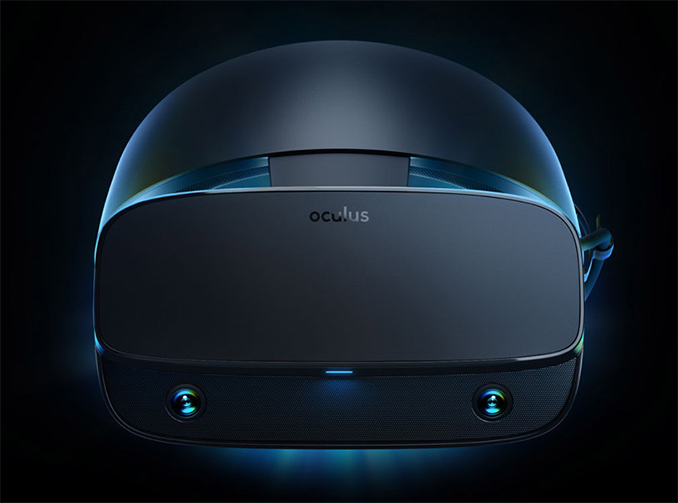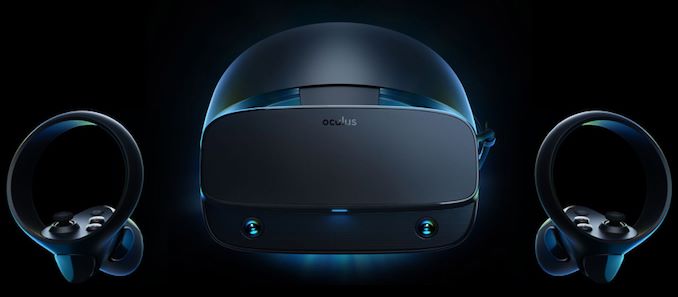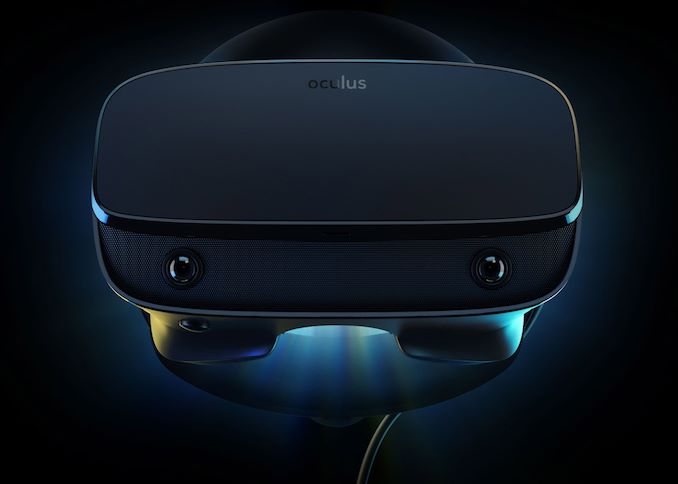Oculus Rift S VR Headset: An Upgraded Virtual Reality Experience
by Anton Shilov on March 20, 2019 2:45 PM EST- Posted in
- VR
- Oculus Rift
- Oculus
- Oculus Rift S

Oculus VR has introduced its new Oculus Rift S virtual reality PC-powered headset. The new head mounted display (HMD) features an inside-out tracking and does not require any external sensors. In a generational update, it has a higher-resolution screen when compared to the original Oculus Rift. The new unit will ship this Spring.
Co-designed by Oculus VR and Lenovo, the Oculus Rift S is a natural evolution (not a major upgrade) of the original HMD that improves it in almost every aspect, including quality of VR experience, a more convenient tracking, and even better ergonomics. The original Oculus Rift and the Oculus Rift S will share the same core platform, enabling owners of both to access VR content developed for either HMD. In fact, even PC requirements for both headsets are the same.
The Oculus Rift S VR headset is equipped with a brand-new display featuring a higher pixel density than before as well as an all-new optics with improved Fresnel lenses for more vivid colors. The company does not disclose resolution of the new HMD officially, but there are claims that the device uses a 5.5-inch display panel with a 2560×1440 (538 ppi, 1280×1440 per eye) resolution and an 80 Hz refresh rate, which is also found inside the Oculus Go. As for audio, the unit has an integrated near-ear speakers in addition to a headphone jack.
The new headset also comes with a built-in inside-out 6-degree-of-freedom (6DoF) Oculus Insight positional tracking (designed for the Oculus Quest) and therefore does not need any external sensors like the original Oculus Rift. Apart from internal sensors, the HMD has five inside-out tracking sensors to track the new Touch controllers and let users observe their surroundings without taking off the HMD.
Because of its collaboration with Lenovo, Oculus VR has managed to develop a headset with a better weight distribution and a more convenient head strap, the company said.
Oculus VR intends to start selling the Oculus Rift S VR headset this spring at a price of $399. The company does not specify the exact launch date, but the wait should not be too long.
Related Reading:
- Oculus Quest Announced: A 6DoF Standalone VR Headset
- Oculus Go Now Available: Mainstream Standalone VR Headset Starts at $199
- HTC Vive Pro HMD Pre-orders Start Today for $799; Vive Reduced to $499
Sources: Oculus, Adam Savage’s Tested, TechCrunch, The Verge












24 Comments
View All Comments
DigitalFreak - Wednesday, March 20, 2019 - link
Nice. I may pick one of these up to replace my current Rift. I was never able to get it working properly with the external cameras due to room layout.The Chill Blueberry - Wednesday, March 20, 2019 - link
I've had problems too but after a complete system reinstall (uninstalling steam VR and all the HTC drivers, updating the firmware on all the hardware.. reinstalling everything.. pretty tedious) its been alright.Midwayman - Wednesday, March 20, 2019 - link
"Upgraded" No IPD adjustment. Lower refresh. Worse color. Worse tracking. Worse 'headphones' I'd say this version is a net negative vs the CV1.The Chill Blueberry - Wednesday, March 20, 2019 - link
Totally, I don't understand what they are going for, except maybe a larger margin on a cheaper product.rtho782 - Thursday, March 21, 2019 - link
I'd agree except that it's more expensive!The Chill Blueberry - Wednesday, March 20, 2019 - link
The timing would be good for HTC to up the game for real. A high-res VR headset would also drive GPU purchases that are pretty slow atm. The graphics cards are there, we just need a good reason to buy them. A new-gen VR headset would be that.Beaver M. - Thursday, March 21, 2019 - link
Graphics cards are still 2 or 3 generations behind VR. They are far too slow for proper graphics comparable to normal games and 90 Hz displays. And that (and a humane price of those graphics cards) ist still the no. 1 reason why VR doesnt take off fully.FullmetalTitan - Friday, March 22, 2019 - link
Also Nvidia went all in on new hardware accelerators this generation of consumer cards, so the actual performance difference between a new card and a 3 year old card is smaller than it's been in quite a long time. Mainstream mid-tier cards (<$300) are at least another full generation or two away from being able to power 1440p-2160p HMDs at a comfortable refresh rate, but higher tier ($300-500) cards are right on that edge now, and the halo products from both red and green teams can manage currently (for $700-1000).Beaver M. - Saturday, March 23, 2019 - link
Nope. You can maybe power one 60 Hz display in 4k with one card that costs $1500.But not 2 90 Hz ones.
2 1080p maybe work with such a card, but everyone knows 1080p is a far too low resolution for VR.
bloodgain - Wednesday, March 20, 2019 - link
The tracking may not be as bad as you think. I get excellent tracking on my Samsung Odyssey+, except if my hands are behind me, and some early hands-on tests indicate Oculus' inside-out tracking may be even better.In the long run, I think inside-out tracking with the assistance of in-controller sensors is going to be the way to go. Most people don't have a room to dedicate to VR, and inside-out tracking is far more accessible. It'll only get better, and a larer user base is good for current users, too.
As for headphones, I can see it both ways. I think I'd rather have "good enough" but removable/replaceable. The AKG phones on the Odyssey+ sound good, but they don't isolate that well and are the only option for that HMD. I'm excited about the Quest in part because I can use my own IEMs for private and sound-isolating listening while playing games or watching movies while travelling.